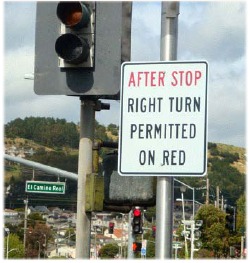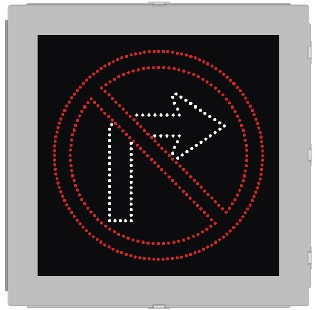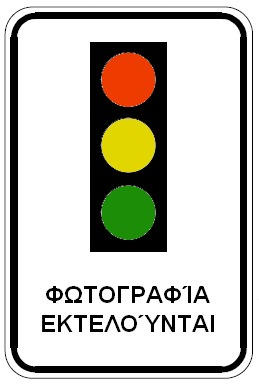If you haven't already done so, please read the Home page
(There is no requirement to post signs at right turns
saying, "stop before turning" or something like that.
See the bottom of this page for more details.)
Warning Sign
Requirements
In case you are getting lost, here is
how you got here:
Home > Defect # 4 > Warning
Sign Requirements
Home - Exp > Defect # 4 - Exp
> Warning Sign Requirements
New 12-9-02, updated 9-29-12:
Until Jan. 1, 2013, the Vehicle Code (excerpted below) required the posting of warning signs like the one depicted below, "visible to traffic approaching from all directions" at each camera-equipped intersection, or at all the main entrances to town. Most cities posted enough signs but not all signs complied with the CalTrans specifications - particularly as to the minimum size of 30 x 42 inches.
CVC 21455.5. (a) The limit line, the intersection,
or a place designated in Section 21455, where a driver
is required to stop, may be equipped with an automated
enforcement system if the governmental agency
utilizing the system meets all of the following
requirements: (1) Identifies the system by signs that
clearly indicate the system's presence and are visible
to traffic approaching from all directions, or posts
signs at all major entrances to the city, including,
at a minimum, freeways, bridges, and state highway
routes. (Former version of CVC 21455.5(a).)
After Jan. 1, 2013, a new law (see SB 1303 on the
Legis page) requires that there be a sign near each
camera - and there no longer is the option to post
the entrances to town.
Here are some of the other laws about road signs.
CVC 21400. The Department of Transportation shall, after consultation with local agencies and public hearings, adopt rules and regulations prescribing uniform standards and specifications for all official traffic control devices placed pursuant to this code, including, but not limited to, stop signs, yield right-of-way signs, speed restriction signs...
CVC 21401. (a) Except as provided in Section 21374, only those official traffic control devices that conform to the uniform standards and specifications promulgated by the Department of Transportation shall be placed upon a street or highway...
CVC 21465. No person shall place, maintain, or display upon, or in view of, any highway any unofficial sign, signal, device, or marking, or any sign, signal, device, or marking which purports to be or is an imitation of, or resembles, an official traffic control device or which attempts to direct the movement of traffic or which hides from view any official traffic control device.
CVC 21467. Every prohibited sign, signal, device, or light is a public nuisance, and the Department of Transportation, members of the California Highway Patrol, and local authorities are hereby authorized and empowered without notice to remove the same, or cause the same to be removed, or the Director of Transportation, the commissioner, or local authorities may bring an action as provided by law to abate such nuisance.

You can also download two clearer versions of this
chart, as follows.
If you would like to see a somewhat
clearer scan of this document, click here:
Warning Sign Reqs., with Signature (jpeg -
80 kb)
If you would like to see a very clear pdf copy of
this document, but without signature, click here:
Warning
Sign Reqs., without Signature (pdf - 15 kb)
This document is not yet available on the CalTrans
website.
More About This Issue Before The Courts
If "your" city has
undersized signs and you are going to raise that issue
in court, you will need to be prepared to deal with
the following sort of reasoning by the judge: During
a Sept. 2003 trial of a ticket issued before Culver
City's March 2003 posting of full-sized signs, Comm.
Amado ruled that (overall) size doesn't matter - since
the picture of the signal and the lettering on the
then-undersized signs were the same size as those
required for the full-sized signs, the fact that the
overall dimensions were too small would not
matter. Judges in other towns may see it the
same way - or differently, of course.
Culver City: During the Aug. 5, 2004 trial of
a ticket issued at Sepulveda / Machado in Culver City
the defendant pointed out that there was no warning
sign on the large driveway (for a housing complex)
that makes up the 4th side of that intersection.
Comm. Amado ruled that it is not required to post
signs facing traffic coming from private property.
CalTrans Letter
Here is an August 2003 CalTrans letter
giving their official position about sign
requirements.
If you want to use
this letter in court, you'll need to call CalTrans and
get them to mail you a paper copy with a signature in
ink. Such a letter isn't hearsay when it's from
a government official. It comes under an
exception called official writings. The
exception is necessary so that high government
officials don't have to spend all their time
testifying about government policy in courts all over
the place.
| STATE OF
CALIFORNIA BUSINESS,TRANSPORTATION AND HOUSING AGENCY GRAY DAVIS, Governor DEPARTMENT OF TRANSPORTATION DIVISION OF TRAFFIC OPERATIONS 1120 N STREET, MS 36 P. O. BOX 942873 SACRAMENTO, CA 94273-0001 PHONE (916) 654-2352 FAX (916) 653-6080 TTY (916) 653-4086 Flex your power! Be energy efficient! August 6, 2003 Dear Mr. ---------: I am responding to your telephone call about the PHOTO ENFORCED (SR56) sign. I hope the following information will be helpful. The California Department of Transportation (Department) is responsible for developing standards and specifications for traffic signs. For the last 5 years I have been in charge of the Signs and Work Zones Branch, which designs official traffic signs for use on all public roadways in the State of California. California Vehicle Code (CVC) Section 21400 provides that the Department shall, after consultation with local agencies and public hearings, adopt rules and regulations prescribing uniform standards and specifications for all official traffic control devices placed pursuant to the provisions of the CVC. CVC Section 21401 provides that only those official traffic control devices that conform to the uniform standards and specifications promulgated by the Department shall be placed upon a street or highway. In keeping with the requirements of CVC Section 21400 the Department established the California Traffic Control Devices Committee to consult with local agencies. The Committee is comprised of representatives of State and local governments. The Committee holds public hearings at least 3 times during each calendar year. For more information, visit the California Traffic Control Device Committee’s homepage at: http://www.dot.ca.gov/hq/traffops/signtech/newtech/index.htm The PHOTO ENFORCED (SR56) sign was adopted by the Department on September 5, 1996, after consultation with the California Traffic Control Devices Committee and public hearings. The adopted specification for the SR56 is enclosed. It is the official standard of the Department. It has not changed since it was originally signed. The SR56 specification and other sign specifications are available for purchase at: Department of Transportation Publication Distribution Unit 1900 Royal Oaks Drive Sacramento, California 95815-3800 (916) 445-3520 The style, font, size and spacing of letters and numerals on traffic signs conform to the requirements specified in the Federal Highway Administration (FHWA) publication entitled "Standard Alphabets for Highway Signs and Pavement Markings," which is available for purchase from the FHWA web site at:http://mutcd.fhwa.dot.gov/ser-pubs.htm The Department and local agencies have some flexibility in the size of signs. However, signs must be conspicuous and legible to drivers. In Section 4-01.12 of the Department’s 1996 Traffic Manual it states, “Larger sizes may be used where greater legibility or emphasis is needed. Special signs or large signs are prescribed for freeways and expressways. Under special conditions such as alleys, limited parkway widths, parking facilities, parks, etc., the use of approved sizes smaller than standard size signs may be justified based on engineering judgement. When sign sizes are changed, standard shapes and colors shall be used and standard proportions shall be retained insofar as practicable.” The 1996 Traffic Manual is available for viewing on the Department’s web site at: http://www.dot.ca.gov/hq/traffops/signtech/signdel/trafficmanual.htm Cities and counties, not the Department, are responsible for installing signs on local streets and roads. CVC Section 21100 (d) allows local authorities to adopt rules and regulations for regulating traffic by means of official traffic control devices meeting the requirements of CVC Section 21400. CVC Section 21351 allows local authorities to place and maintain such official traffic control devices. Thank you for writing. I hope this helps. Sincerely, Greg Edwards, Chief Highway Signs and Work Zones Branch (916) 654-3507 Enclosures: |
Signs for Right Turns?
There is no
requirement to post signs at right turns saying, "Stop
Before Turning" or something like that.
If there was such a requirement, there would have
to be four such signs at every signalized intersection
in California. So, the requirement is simply
something you are supposed to know, and is part of the
written driving test.
If a city decided to make up their own signs saying
"Stop Before Turning" or "After Stop, Right Turn
Permitted on Red," they would be in violation of CVC
21401 and 21465 (above).
If you could swear that you
have seen such a sign, you may have been to South
San Francisco, or Millbrae.

Sign in South San Francisco, from 2010 Grand
Jury Report
At an intersection
where rolling right turns are a major safety problem and
camera enforcement has failed to reduce the violations,
and at those few locations where it's necessary to
prevent all right turns during the red, the city
should install a Blank Out sign. Blank Out signs
are large (24" x 24" or bigger) electrically-powered
signs whose messages are not visible when the power is
off. Thus, they provide the ability to prohibit
right turns during selected portions of the signal
cycle.
This Blank Out sign has the added advantage that its
message is not in English - see Why Not in
Greek, below.

Blank Out Sign
Federal
Guidelines for Signs
From Chapter V. of the Federal Highway Administration's Red Light Camera Systems Operational Guidelines (with emphasis added):
( Please note that these are guidelines and compliance is not mandatory; in the Introduction to the Guidelines, it says, "Although not a regulatory requirement, the guideline is intended to provide critical information for State and local agencies on relevant aspects of red light camera systems in order to promote consistency, proper implementation, and operation..." )
| Federal Guidelines, Chapter V.,
Warning Signs section (pg. 21, or 27th pg. of
the pdf) Signs warning motorists that red light cameras are being used are typically required by law or ordinance, but whether required or not, should be posted as part of the driver awareness and education process. These warning signs may be placed in the following locations at photo-enforced intersections: · In advance of photo-enforced intersections. · At photo-enforced intersections, typically on the far side traffic signal pole. · On all approaches into an area where red light camera systems are used for red light running. Warning signs placed on all approaches into an area, while used to satisfy legal requirements in some jurisdictions, are appropriate as supplemental warning signs but not as the primary warning for motorists. Advance warning signs should be installed at photo-enforced intersections. All advance warning signs should be clearly visible and compliant with the MUTCD (17). |
California has adopted its own version of the
Federal guidance applicable to sign placement. My
detailed discussion is at:
Sign
Placement - New (MUTCD) Guidance.
Why Not In Greek?
We have a lot of tourists in California, and due to
the State's size and general lack of a public
transportation system many of them rent cars and
drive.
For those not fluent in English, the
CalTrans-approved "Photo Enforced" warning signs might
look like this:

...and South San Francisco's "After Stop, Right Turn Permitted on Red" sign must look like this:

The two signs above were made up by
highwayrobbery.net. We are sure that in Greece
and Mexico, the warning signs use international
symbols that can be understood by all nationalities.
Here is a sign not made up by
highwayrobbery.net.

Actual Blank Out Sign on Canoga Avenue in LA
This Blank Out sign has been set up to flash, in an effort to prevent motorists from making right turns on red across Metro's Orange Line busway in Los Angeles. But it hasn't been effective, probably because it depends upon the motorist's understanding of an English word and also fails to tell the driver what to do, or not to do (don't turn right).
Further, it is an unapproved sign (not listed in CalTrans' MUTCD), so exposes Metro and the City of LA to liability in the event of an accident.
---------------------------------
RED LIGHT
CAMERAS
www.highwayrobbery.net
www.highwayrobbery.net